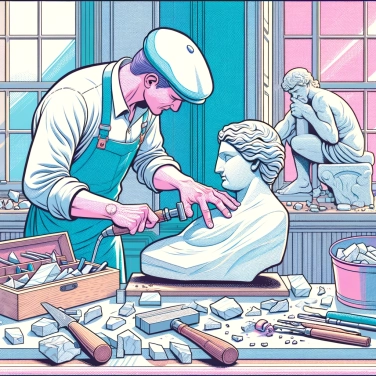Marble sculpture is demanding because of the hardness and fragility of this material, requiring specific tools and techniques. Furthermore, the precision required to sculpt in marble makes it a complex and demanding artistic work.

Marble is a hard yet fragile rock, which forces the sculptor to exercise extreme caution. The slightest misstep or too powerful a strike can cause a crack or even break an entire piece, often impossible to repair. Since marble has veins and crystals, it is difficult to work with uniformly: the sculptor must constantly adapt their technique to these particularities. Some areas may be more brittle, while others are very hard, making sculpting demanding and not always predictable. Furthermore, the very nature of marble limits possible corrections: it is impossible to apply a layer or erase a mistake as one would on a canvas. Here, every movement must be deliberate because it is irreversible.
Sculpting marble leaves no second chances. Every gesture is definitive, and the sculptor must work with extreme precision to avoid ruining the entire piece. You attack the stone with a chisel or a point chisel, two tools that require true craftsmanship. The point chisel allows you to roughly outline and quickly remove material with bold strokes, while the chisel is used for shaping with ultra-precise touch-ups. Each strike of the mallet on the tool requires perfect control: too hard, you risk cracking or breaking the stone; too soft, your gesture is imprecise and loses its sharpness. This mastery of technique demands genuine manual skill, acquired through experience and patience.
Marble, due to its hardness and lack of elasticity, forgives no mistakes. It is therefore impossible to correct an error by adding material, as one would with clay or plaster: here, every wrong move is permanent. The artist is forced to constantly adapt to the stone itself, taking into account its internal imperfections: hidden cracks, irregular veining, or unexpected color variations. These uncertainties make artistic expression delicate, often requiring adjustments to the composition to take advantage of the material as it is. All of this significantly restricts creative freedom, but also pushes artistic reflection to the maximum, forcing the sculptor to anticipate every detail well in advance. Knowing how to compose with these constraints is therefore fundamental: marble guides the artist as much as the opposite, imposing a constant dialogue between the raw material and the creator's vision.
Marble is certainly a solid stone, but it remains fragile in the face of many everyday elements such as temperature variations, atmospheric pollutants, or even simply acid rain. All of this can wear down, discolor, or crack a sculpture over time. To protect it, it often requires the application of preventive treatments or regular restoration. This necessitates vigilance and regular maintenance to preserve the initial appearance and avoid unexpected damage. We are talking about a demanding material that leaves little room for error in terms of maintenance, especially if the sculpture is exposed outdoors.
The Carrara marble, particularly valued in sculpture, was already being extracted during Roman times for its exceptional properties of fineness and purity.
To sculpt marble, artists use both direct percussion tools such as hammers and chisels, as well as more delicate tools like files and polishers to achieve a subtle and shiny finish.
Michelangelo's "Pietà" is one of the few works signed by the artist, with his signature subtly appearing on the belt crossing the chest of the Virgin Mary.
Some blocks of marble reveal hidden cracks or internal impurities during the carving process, forcing sculptors to improvise or significantly alter their initially planned work.
The white marble offers a unique brightness, a certain visual purity, as well as a subtle translucency. These characteristics highlight the play of shadow and light and enhance the details, facilitating realistic and expressive representation in artworks.
Unlike clay or plaster, marble allows for no direct correction. An error necessitates either a complete rethinking of the work or an adaptation of the original concept, as it is impossible to add back the material that has been removed.
The essential tools include chisels, straight and flat chisels, points, mallets, as well as files or scrapers for finishing. Today, some sculptors also use mechanical tools such as pneumatic hammers to achieve greater speed and precision.
To effectively maintain a marble sculpture, it is advisable to regularly dust it with a soft cloth, avoid prolonged exposure to moisture and acids as much as possible, and ensure thermal stability to prevent any risk of cracking or alteration.
The time required depends on the size, level of detail, and artistic complexity. A small sculpture may take a few weeks, while a monumental or highly detailed piece can require several months or even years of work.

No one has answered this quiz yet, be the first!' :-)
Question 1/5